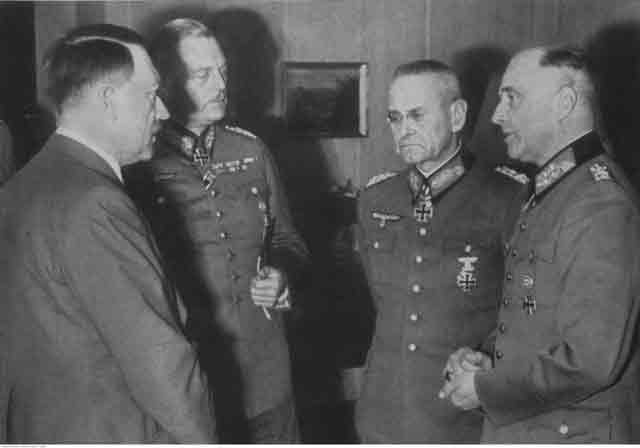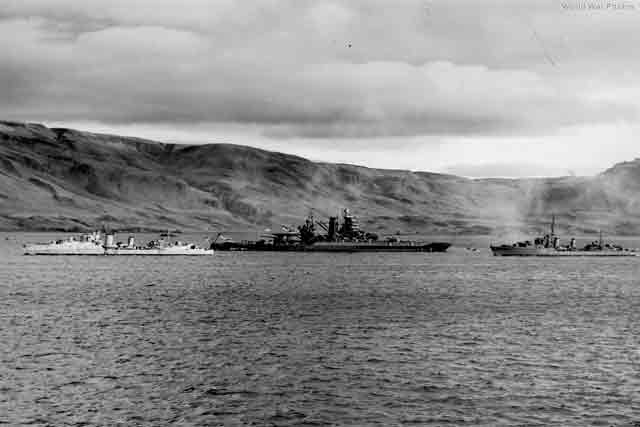Saturday 4 October 1941
 |
| Adolf Hitler meets with Chief of the OKW Field Marshal Wilhelm Keitel, Chief of the General Staff of the OKH Colonel-General Halder, and Commander-in-Chief of the Army Field Marshal Walther von Brauchitsch. This is at the headquarters of the Army High Command and the occasion is Brauchitsch's 60th birthday (Federal Archives Picture 183-L20362). |
Eastern Front: There are many dark moments during World War II for Soviet leader Joseph Stalin. Among these are the first days of Operation Barbarossa, when he unsuccessfully begs Hitler for peace via a Bulgarian emissary. Perhaps the greatest, however, is in the first two weeks of October. On
4 October 1941, signs begin to emerge that Stalin fears that the war is lost and all that is left is to await the end. Today, we might say that Stalin is "losing his nerve."
 |
| 20th Panzer Division troops of Army Group North supported by a Panzer 38(t) made in Czechoslovakia enter a pine grove near Leningrad during October 1941. To be more precise, that is Panzerkampfwagen 38 (t) Ausf. S (Sd.Kfz. 140) Nr. 9 (Gebauer, Federal Archive Bild 101I-213-0267-13). |
Lieutenant-General Ivan Konev is the commander of Western Front. This force is defending the high road to Moscow that runs through Minsk and Smolensk. Currently, Konev's troops are fighting the Vyazma Defensive Operation and having a very tough time of it, with German pincers threatening a massive encirclement at Vyazma - the last major city before Moscow. Loss of Western Front, whose main component is the Konev's former command 19th Army (General M.F. Lukin) would make a successful defense of Moscow extremely difficult. Konev recalls:
On 4 October I reported to Stalin about the situation in the Western Front and about the enemy penetration of the Reserve Front... and also about the threat of a large enemy grouping reaching our forces' rear area...Stalin listened to me, however, made no decision. Communications were disrupted and further conversation ceased.
To sum up, Stalin is paralyzed and incapable of making decisions. However, in the Soviet state, nobody dares to make any decisions on their own without approval from the Stavka - and Stalin controls the Stavka. It is a very dangerous situation for the Red Army.
 |
| The Illustrated London News, October 4, 1941. |
Stalin has good reason to be scared. German General Erich Hoepner's Panzer Group 4, composed primarily of LVI Panzer Corps (Erich von Manstein) and XLI Panzer Corps (George-Hans Reinhardt) is attacking Vyazma from the south while General Hermann Hoth's Panzer Group 3 is approaching it from the north. Should those two forces meet in the vicinity of Vyazma, the Red Army could lose another massive force (31 Rifle Divisions, 3 Cavalry Divisions, 2 Motorized Divisions, and 3 tank Brigades). Today, Hoepner eliminates Soviet 33rd and 43rd Armies as it captures Kirov and Spa-Demensk, not far to the southwest of Vyazma. Soviet Group (Ivan) Boldin is counterattacking Hoth's panzers, but Hoth, having reached an area southwest of Belyi, decides to head due east to sideslip the Soviet defenders for a deeper encirclement. Hoth also sends VI Army Corps north to take Belyi, which the Soviets contest bitterly.
 |
| USS Mississippi (BB-41) and RN destroyers at Hvalfjordur, Iceland on 4 October 1941 (US Navy). |
Stalin's refusal to issue orders means that the endangered Soviet troops are not authorized to retreat. Without authorization to retreat, no Soviet commanders will issue such orders lest they suffer the same fate as generals like Pavlov in the early days of the war who were shot for "cowardice." Thus, another situation like Kyiv is developing, where any retreat orders may be issued too late and a giant hole may be blown through the Soviet lines - one that points directly at Moscow.
 |
| SB2U Vindicator code 42-S-17 of VS-42 in flight over the carrier USS Ranger CV-4 sometime during October 1941 (US Navy). |
As with all other successful German offensives, the Luftwaffe has complete control of the skies. Air support is a critical component of the Blitzkrieg formula, and there are many top German aces clearing the way for the army. Luftwaffe fighter squadron JG 27 has a particularly good day, with the pilots starting early in the morning and flying multiple missions. Oblt. Erbo Graf von Kageneck of 9./JG 27 claims three Soviet planes - a DB-3, an SB-2, and a Pe-2 - and finishes the day with 60 victories. Ofw. Erwin Sallwisch of Stab/JG 27 (the headquarters group) claims four Soviet I-18 planes during the day. Top ace Hannes Trautloft of the same group downs an I-26, while several other JG 27 pilots also claim victories.
It is a virtual shooting gallery in the skies because these are areas the Red Air Force must defend, and so they are forced to do battle and be shot down. However, there are always more Soviet planes to replace the ones lost, which may be welcomed by victory-hungry Luftwaffe pilots but which is a troubling omen for the future.
 |
| Starlet Glynis Johns on the cover of Picture Post magazine, 4 October 1941. She is promoting her 1941 film "49th Parallel," a British propaganda film about German sailors on the run in Canada. Incidentally, Glynis Johns, born in Pretoria, South Africa, is still alive as of 2019, though, apparently, she retired at the very end of the 20th Century. She was in Sandra Bullock's 1995 film "While You Were Sleeping" and in "Superstar" (1999). |
October 1941
October 1, 1941: Germans and Finns Advance in USSR
October 2, 1941: Operation Typhoon Broadens
October 3, 1941: Air Battles Near Moscow
October 4, 1941: Stalin Contemplates Defeat
October 5, 1941: Hoth Goes South
October 6, 1941: First Snowfall After Dark
October 7, 1941: Stalin Gets Religion
October 8, 1941: FDR Promises Stalin Aid
October 9, 1941: FDR Orders Atomic Bomb Research
October 10, 1941: Reichenau's Severity Order
October 11, 1941: Tank Panic in Moscow
October 12, 1941: Spanish Blue Division at the Front
October 13, 1941: Attack on Moscow
October 14, 1941: Germans Take Kalinin
October 15, 1941: Soviets Evacuate Odessa
October 16, 1941: Romanians Occupy Odessa
October 17, 1941: U-568 Torpedoes USS Kearny
October 18, 1941: Tojo Takes Tokyo
October 19, 1941: Germans Take Mozhaysk
October 20, 1941: Germans Attack Toward Tikhvin
October 21, 1941: Rasputitsa Hits Russia
October 22, 1941: Germans Into Moscow's Second Defensive Line
October 23, 1941: The Odessa Massacre
October 24, 1941: Guderian's Desperate Drive North
October 25, 1941: FDR Warns Hitler About Massacres
October 26, 1941: Guderian Drives Toward Tula
October 27, 1941: Manstein Busts Loose
October 28, 1941: Soviet Executions
October 29, 1941: Guderian Reaches Tula
October 30, 1941: Guderian Stopped at Tula
October 31, 1941: USS Reuben James Sunk
2020







No comments:
Post a Comment